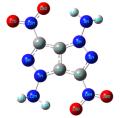[1] Luo, Y.-F.; Ge, Z.-X.; Wang, B.-Z.; Zhang, H.-H.; Liu, Q. Chin. J.Energ. Mater. 2007, 15(3), 205 (in Chinese).(罗义芬, 葛忠学, 王伯周, 张海昊, 刘愆, 含能材料, 2007,15(3), 205.)[2] Philip, F. P.; Gregory, S. L.; Alexander, R. M.; Robert, D. S. Thermochim.Acta 2002, 384, 187.  [3] Vasilii, M. V.; Lgor, L. D.; Svyatoslav, A. S. Mendeleev Commun.1993, 111.[4] Tamura, Y.; Minamikawa, J.; Sumoto, K.; Fujii, S.; Ikeda, M. J.Org. Chem. 1973, 38(6), 1239.[5] Patel, H. P.; Tedder, J. M. J. Chem. Soc. 1963, 4589. [3] Vasilii, M. V.; Lgor, L. D.; Svyatoslav, A. S. Mendeleev Commun.1993, 111.[4] Tamura, Y.; Minamikawa, J.; Sumoto, K.; Fujii, S.; Ikeda, M. J.Org. Chem. 1973, 38(6), 1239.[5] Patel, H. P.; Tedder, J. M. J. Chem. Soc. 1963, 4589.  [6] Gouki, F.; Yuichi, K.; Tanezo, T. Yakugaku Zasshi 1974, 94(1), 17.[7] Шевелев, C. A.; Далингер, И. Л.; Щкинева, Т. K. Proc. Acad. Sci.Ser. Chem. 1993, 6, 1108.[9] Wang, B.-Z.; Lai, W.-P.; Liu, Q.; Lian, P.; Xue, Y.-Q. Chin. J. Org.Chem. 2008, 28, 422 (in Chinese).(王伯周, 来蔚鹏, 刘愆, 廉鹏, 薛永强, 有机化学, 2008, 28,422.)[10] Fan, Y.-J.; Wang, B.-Z.; Lai, W.-P.; Lian, P.; Jiang, J.; Wang, X.-J.;Xue, Y.-Q. Chin. J. Org. Chem. 2009, 29(4), 617 (in Chinese).(范艳洁, 王伯周, 来蔚鹏, 廉鹏, 姜俊, 王锡杰, 薛永强, 有机化学, 2009, 29(4), 617.)[11] Wang, X.-J.; Lian, P.; Ge, Z.-X.; Wang, B.-Z.; Xue, Y.-Q.; Qin,G.-M. Acta Chim. Sinica 2010, 68(6), 557 (in Chinese).(王锡杰, 廉鹏, 葛忠学, 王伯周, 薛永强, 覃光明, 化学学报,2010, 68(6), 557.)[12] Wu, Y.-X.; Wang, S.-G. Chem. J. Chin. Univ. 2011, 32(1), 161 (inChinese).(伍毅翔, 王曙光, 高等学校化学学报, 2011, 32(1), 161.)[13] Ye, B.; Xu, X. Chem. J. Chin. Univ. 2010, 31(12), 2431 (in Chinese).(叶冰, 许旋, 高等学校化学学报, 2010, 31(12), 2431.)[14] Liu, Y.-H; Liu, H.; Liu, J.-Y.; Lv, Z.-Y. Chem. J. Chin. Univ. 2011,32(2), 332 (in Chinese).(刘玉华, 刘鸿, 刘靖尧, 吕中元, 高等学校化学学报, 2011,32(2), 332.) [6] Gouki, F.; Yuichi, K.; Tanezo, T. Yakugaku Zasshi 1974, 94(1), 17.[7] Шевелев, C. A.; Далингер, И. Л.; Щкинева, Т. K. Proc. Acad. Sci.Ser. Chem. 1993, 6, 1108.[9] Wang, B.-Z.; Lai, W.-P.; Liu, Q.; Lian, P.; Xue, Y.-Q. Chin. J. Org.Chem. 2008, 28, 422 (in Chinese).(王伯周, 来蔚鹏, 刘愆, 廉鹏, 薛永强, 有机化学, 2008, 28,422.)[10] Fan, Y.-J.; Wang, B.-Z.; Lai, W.-P.; Lian, P.; Jiang, J.; Wang, X.-J.;Xue, Y.-Q. Chin. J. Org. Chem. 2009, 29(4), 617 (in Chinese).(范艳洁, 王伯周, 来蔚鹏, 廉鹏, 姜俊, 王锡杰, 薛永强, 有机化学, 2009, 29(4), 617.)[11] Wang, X.-J.; Lian, P.; Ge, Z.-X.; Wang, B.-Z.; Xue, Y.-Q.; Qin,G.-M. Acta Chim. Sinica 2010, 68(6), 557 (in Chinese).(王锡杰, 廉鹏, 葛忠学, 王伯周, 薛永强, 覃光明, 化学学报,2010, 68(6), 557.)[12] Wu, Y.-X.; Wang, S.-G. Chem. J. Chin. Univ. 2011, 32(1), 161 (inChinese).(伍毅翔, 王曙光, 高等学校化学学报, 2011, 32(1), 161.)[13] Ye, B.; Xu, X. Chem. J. Chin. Univ. 2010, 31(12), 2431 (in Chinese).(叶冰, 许旋, 高等学校化学学报, 2010, 31(12), 2431.)[14] Liu, Y.-H; Liu, H.; Liu, J.-Y.; Lv, Z.-Y. Chem. J. Chin. Univ. 2011,32(2), 332 (in Chinese).(刘玉华, 刘鸿, 刘靖尧, 吕中元, 高等学校化学学报, 2011,32(2), 332.) |
